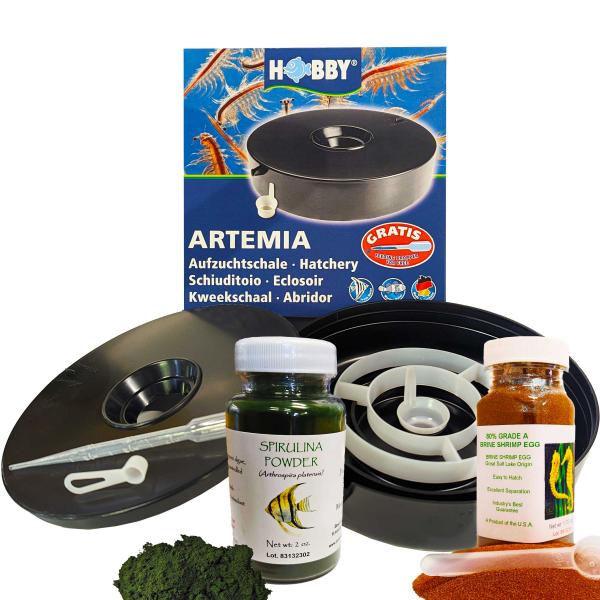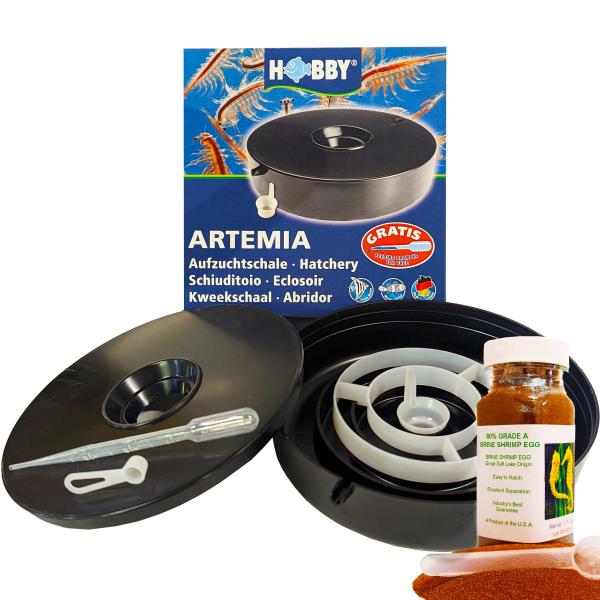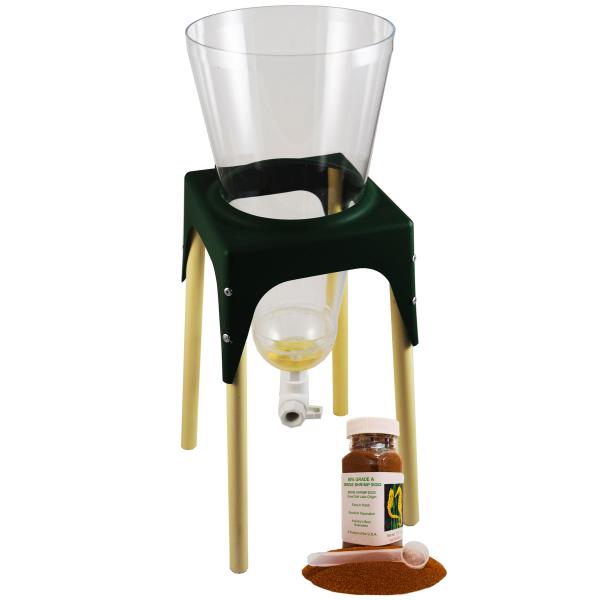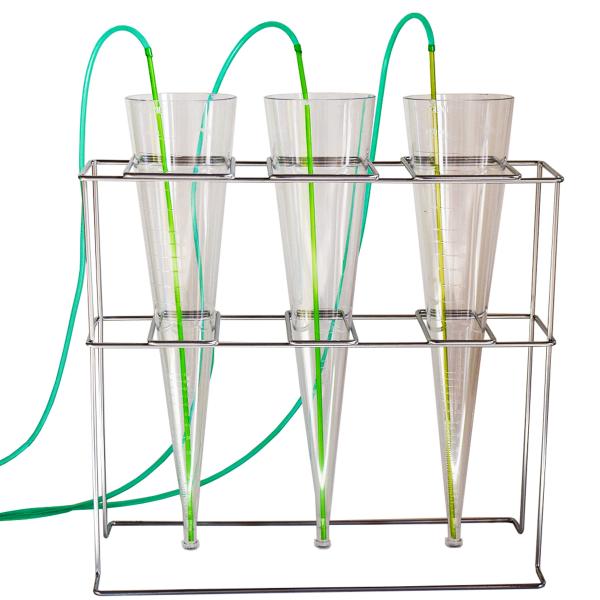Instructions for Hatching Brine Shrimp
In the page below you will find the Web's most complete and simple-to-follow brine shrimp hatching instructions for hatching eggs in a conventional cone-shaped container (Imhoff cone or inverted bottle), or using a Hatchery Dish!
Storing Brine Shrimp Eggs
Before we begin, you need to start with viable, properly stored eggs. All brine shrimp eggs need to be stored as follows:
- in a tightly sealed container;
- free from moisture; and
- in a cool environment at or below 40°F. (Refrigeration is ideal for short term storage, i.e., less than three to four weeks. For longer term storage, eggs are best kept at or below freezing.)
We recommend that upon receiving your eggs, divide them into an amount that will be consumed within three to four weeks and store this amount in a tightly sealed container in the refrigerator; the remainder should be stored, also in a tightly sealed container, in the freezer. Keep in mind that freezing can lower metabolic activity and delay hatch-out. We suggest removing egg from the freezer one day in advance of using it to allow the embryos to acclimate.
The above storage guidelines apply to all brine shrimp eggs, whether in opened or unopened tins.
Brine Shrimp Direct Hatching Equipment
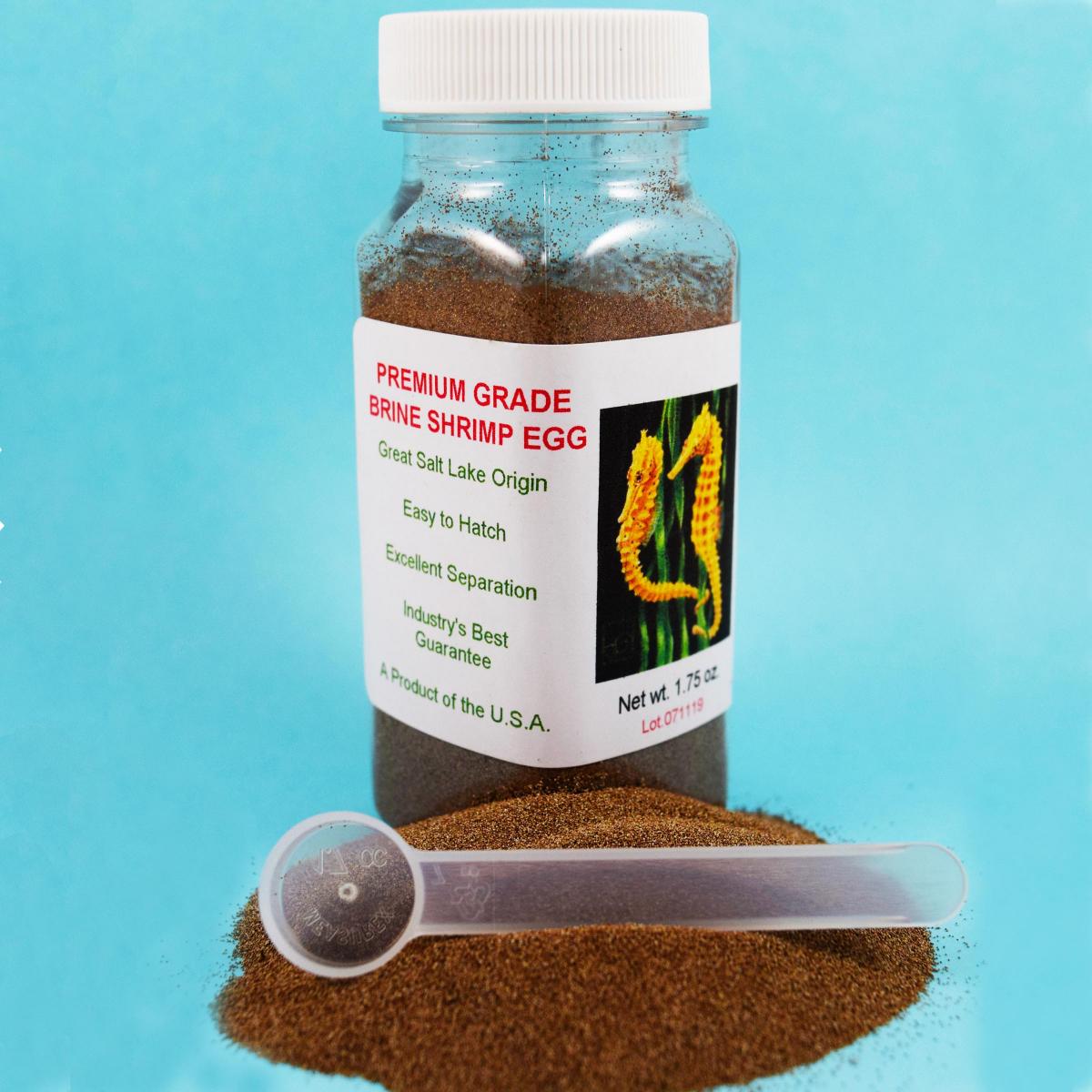
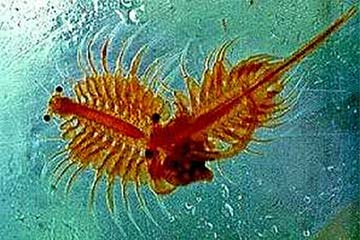
Hatching: Environment Conditions
Follow these guidelines for the best results when using conical hatching containers such as our 2-Liter standing cone, an Imhoff cone, or an inverted soda bottle:
- Salinity:
When preparing your hatching solution, a 25 parts per thousand (ppt) salt solution is ideal under most conditions. This equates to around 1.018 specific gravity as measured with a hydrometer. If you lack a hydrometer, this salinity can be achieved by dissolving approximately 1 and 2/3 tablespoons of salt in one quart (roughly, one liter) of water. Be sure to use non iodized salt. - pH:
Proper pH can be important in hatching brine shrimp. A starting pH of 8.0 or higher is recommended. In areas where the water pH is below 7, Epson salt or magnesium sulfate can be added at the rate of 1/2 teaspoon per quart of hatching solution. - Temperature:
Optimum water temperature for a 24-hour complete hatch is 80-82°F (26-28°C). Lower temperatures will result in a longer hatching time and inefficient hatches. Do not exceed 86° (30°C). Do not place an immersion heater directly into your hatching container! An immersion bath is a preferred method to maintain constant hatching temperatures. Alternatively, an incandescent bulb placed above the hatching cone can provide sufficient heat in the right environment. - Light:
Illumination is necessary to trigger the hatching mechanism within the embryo during the first few hours of incubation. Maintaining a light source during the entire incubation period is recommended to obtain optimum hatch results and, as mentioned above, for temperature control. - Aeration:
Constant aeration is necessary to keep cysts in suspension and to provide sufficient oxygen levels for the cysts to hatch. A minimum of 3 parts per million dissolved oxygen during the incubation is recommended. Strong aeration should not damage or hurt the brine shrimp cysts or nauplii. A [rigid air tube] is ideal to direct air to the bottom of the cone and to prevent unhatched eggs from settling. We do not recommend an airstone. - Stocking Density:
1 gram per liter or quart or approximately 1/2 level teaspoon of cysts per quart (or liter) is recommended for optimum hatching percentages. A higher stocking density will result in a lower hatch percentage and difficulty separating hatched nauplii from unhatched egg and shell. - Hatching Cone:
Flat-bottom hatching vessels should be avoided. Cone or "V" bottomed containers are best to insure that the cysts remain in suspension during hatching. Be sure to thoroughly wash the hatching cone with a light chlorine solution, rinse, and allow to air-dry between uses. Avoid soap. Soap will leave a slight residue which will foam from aeration during hatching and leave cysts stranded above the water level. - Incubation Period:
Generally, the optimum incubation time is 24 hours. Egg which has been properly stored for more than 2-3 months may require additional incubation time — up to 30-36 hours. Oftentimes, eggs will hatch in as few as 18 hours. If a smaller size nauplii (Instar I) is desired, a harvest time of 18 hours is recommended after which Instar I (first stage) nauplii can be collected before metamorphosis into Instar II.
Helpful Hint:
Brine shrimp egg is sometimes very buoyant. In order to maximize the hatching percentage, it is sometimes helpful to swirl the water inside the hatching container with your finger once or twice at intervals in the first 4 to 6 hours of incubation in order to knock down eggs that have been stranded on the side of the container above the water-line. After about 6 hours, the eggs are usually well-hydrated and will stay in the water column.
Hatching Procedure
The following steps will achieve optimum brine shrimp hatch rates.
- Set Up:
Place hatching cone or similarly shaped vessel in well-lit area. Cone should be semi-translucent for ease of harvesting and light transmission. - Add Water:
Fill cone with water and adjust salinity to 25 ppt (parts per thousand). Optimum hatching temperature is 82°F (28°C). - Add Cysts:
Add cysts at the rate of 1 gram per liter. - Aerate:
Provide adequate aeration to keep cysts in suspension. - Hatch:
Depending upon water temperature, cysts should hatch in approximately 18-36 hours. - Harvest:
After hatching brine shrimp, turn off or remove aeration and wait several minutes for the shells and and baby brine shrimp (or nauplii) to separate. Newly hatched nauplii will settle to the bottom of the cone or move towards a light source; the shells will float to the surface. Once separated, the nauplii can be siphoned from the bottom with a length of air tubing or gently drained through the bottom of the cone through a valve, if so equipped. - Rinse:
The warm incubation temperatures and metabolites from the hatching medium create ideal conditions for a bacteria bloom. Rinsing of the baby brine shrimp in a fine mesh net or sieve using clean fresh or salt water is important before feeding them to your fish. - Clean Equipment:
Tanks and brine shrimp hatching equipment should be cleaned and disinfected routinely.
Hatching Cone:
Flat-bottom hatching vessels should be avoided. Cone or "V" bottomed containers are best to insure that the cysts remain in suspension during hatching. Be sure to thoroughly wash the hatching cone with a light chlorine solution, rinse, and allow to air-dry between uses. Avoid soap. Soap will leave a slight residue which will foam from aeration during hatching and leave cysts stranded above the water level.
Incubation Period:
Generally, the optimum incubation time is 24 hours. Egg which has been properly stored for more than 2-3 months may require additional incubation time — up to 30-36 hours. Oftentimes, eggs will hatch in as few as 18 hours. If a smaller size nauplii (Instar I) is desired, a harvest time of 18 hours is recommended after which Instar I (first stage) nauplii can be collected before metamorphosis into Instar II.
Harvesting or collecting brine shrimp
Harvesting newly hatched nauplii requires some patience and the method used depends upon your equipment and your needs. When collecting from an Imhoff cone or inverted soda bottle, one method is to remove the airline and allow the nauplii to settle to the bottom of the cone. This will take several minutes. As the nauplii accumulate at the apex of the cone, use the airline with rigid tubing attached to siphon the nauplii into a collection dish filled with fresh water. Do not allow the nauplii to become tightly packed at the bottom of the cone and risk suffocation. After siphoning, wait several minutes and repeat. Take care to avoid siphoning the unhatched eggs that normally settle first. If you have difficulty siphoning the newly hatched nauplii without siphoning unhatched eggs or shell, we suggest that you finish siphoning the majority of naupllii into the holding dish, rinse out the cone and then pour the dish containing nauplii and water back into the cone, add clean water to the cone and repeat the siphoning process as the nauplii again settle to the apex of the cone. It is a good practice to pass the nauplii and water through a small mesh to minimize the introduction of the hatching water into the aquarium.
Stay tuned for more advice when harvesting from a 2-Liter Cone equipped with a stopcock or valve at the apex of the cone.
Final thought
Many people, especially experienced aquarists, are comfortable using the method described above, or variations thereof, for collecting or harvesting newly hatched brine shrimp. Regardless of your experience level and quality of the brine shrimp, some unhatched eggs and shell invariably sneak into your aquarium. For most fish and in most situations, this is not a problem. However, sometimes it can be. For situations where unhatched eggs and shell will cause problems, we suggest using the [Hatchery Dish]. This method eliminates the transfer of unhatched eggs and shell into your aquarium. It is ideal for small set-ups and for raising smaller amounts of sensitive fry or for keeping seahorses or jellies.
For large set-ups, commercial hatcheries, public aquarium exhibits and the like, Brine Shrimp Direct offers another tank-tested solution – shell-free EZ Egg! with an 80% hatch-rate.

